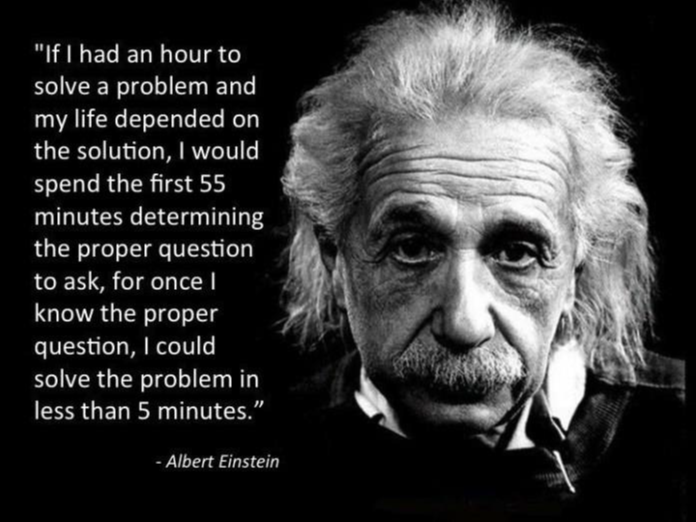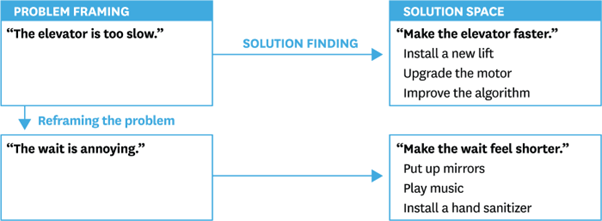The art of reframing problems to find better solutions
“The more radically we shift the frame, the more unique the ideas we generate. Reframing is thus a powerful tool for identifying opportunities.” – Seeling, 2019
Problem-solving is a crucial skill for any organisation aiming to stay competitive, maintain relevance and maximise efficiencies. However, a common pitfall many face is not accurately identifying the root cause of their challenges. While managers and leadership may excel at implementing solutions, many often struggle with diagnosing problems effectively. This issue has significant implications, leading to wasted resources, missed opportunities, and stagnant growth.
Research conducted on 106 C-suite executives representing various companies across 17 countries reveals a fascinating statistic: 85% of organisations believe they are poor at problem diagnosis. This deficiency comes with substantial costs, as 87% of the executives agreed. The prevailing pattern suggests that leaders, potentially driven by a bias for action, tend to rush into trying to implement solutions without fully grasping the underlying problem.
“This is the very problem we face – and why we see so much innovation theatre rather than genuine impact. Initiatives and projects come with an oversimplification of the problem statement. If indeed such a statement exists at all. There’s a lack of penetration into the root causes of problems. We don’t understand our world half as well as we think we do. Most of our organisations have a cultural bias for execution over thorough problem definition. We simply want to get the product on the street. Even if it’s the wrong product (or the wrong street). To have the most impact, it’s simple. Just ask the right questions.” – Taylor, 2017
The importance of problem framing in creativity and innovation has been underscored for decades, yet organisations continue to grapple with this fundamental aspect of problem-solving. In the work we do at Square Holes, we often begin our mission workshops with the below quote from Albert Einstein. This underlines the importance of making sure we conduct the project with the right question in mind. We find this helps all stakeholders involved to understand the importance of framing the mission in the right way and helps us dig a bit deeper into the need for the research and setting critical outcomes. Ultimately ensuring the answers discovered are for the most prevalent business problem.

To address the challenge many organisations have with problem diagnosis, an approach known as reframing is proposed. Reframing involves shifting perspectives to uncover alternative framings of persistent problems, leading to novel and creative solutions. Reframing problems helps organisation to break free from conventional thinking patterns and unlock innovative solutions that may have remained unknown otherwise.
The “Slow Elevator Problem” is a great showcase for the power of reframing. The scenario places you in the shoes of the owner of an office building, with tenants complaining about how old and slow the elevator is, many threatening to break their lease if the problem isn’t resolved. With the need to identify quick solutions, most think of answers such as ‘installing a new lift’, ‘upgrading the motor’ or ‘improving the algorithm’.

Yet, when the problem is presented to others, building managers for example, they think of solutions such ‘putting up mirrors’ or ‘playing music’. Working to reduce compaints by minimising the perceived annoyance of the waiting time. Reframing the issue from a technical one to a user expereince one.

Source: Harvard Business Review, 2017
Both solutions work to solve tenant dissatisfaction, yet the reframing of the problem provided an avenue for a creative, effective, and likely, a less costly resolution.
“The point of reframing is not to find the “real” problem but, rather, to see if there is a better one to solve.” – Wedell-Wedellsborg, 2017
To help implement such an exercise, the Harvard Business Review offers seven best practices to achieve effective problem reframing. These can be used as a step-by-step process, or in more time pressured situations, one or two can be enacted:
- Establish legitimacy: Ensure buy-in from all stakeholders by demonstrating the value and effectiveness of reframing through real-world examples and case studies.
- Bring outsiders into the discussion: Seek perspectives from individuals outside the immediate problem-solving circle to challenge existing assumptions and broaden the scope of solutions.
- Get people’s definitions in writing: Encourage stakeholders to articulate their understanding of the problem in writing to uncover divergent perspectives and nuances.
- Ask what’s missing: Prompt stakeholders to consider what aspects of the problem may have been overlooked or omitted from the initial diagnosis.
- Consider multiple categories: Encourage stakeholders to explore the problem from various angles or categories to uncover alternative framings and potential solutions.
- Analyse positive exceptions: Identify instances when the problem did not occur and analyse what factors contributed to those outcomes, offering insights into alternative approaches.
- Question the objective: Challenge predefined objectives and goals to ensure alignment with the desired outcomes and explore alternative paths to success.
Incorporating these practices into problem-solving processes can enhance organisations’ ability to identify and address underlying issues effectively. However, mastering the art of reframing requires time, practice, and a willingness to embrace ambiguity and uncertainty. Despite the prevalence many face in accurately diagnosing problems, reframing emerges as a powerful approach to uncovering alternative perspectives and generating innovative solutions.




